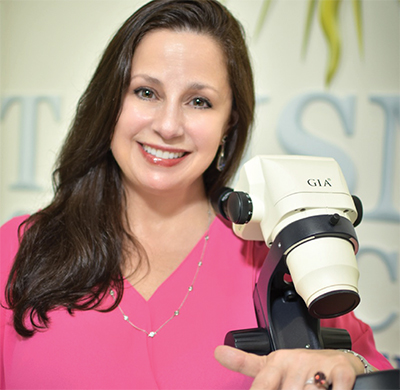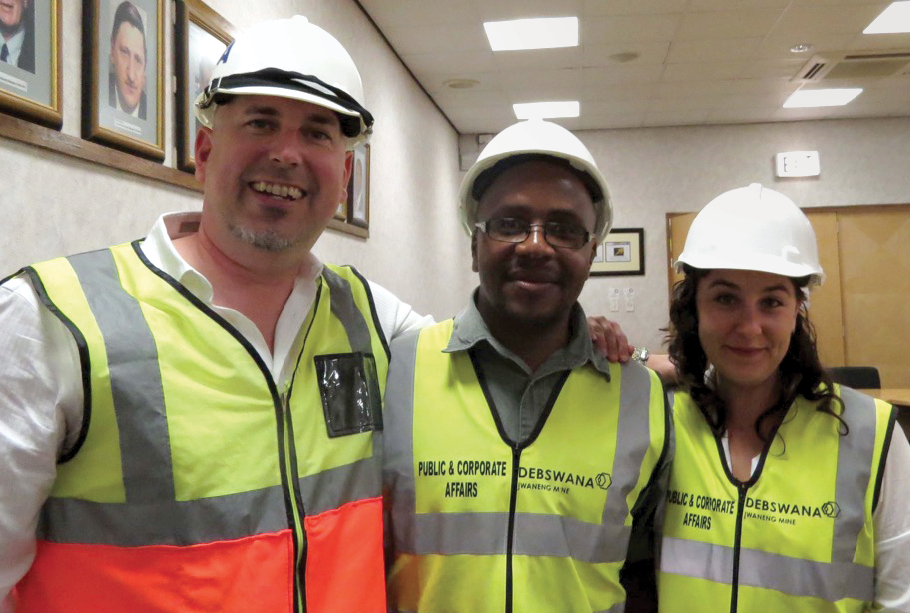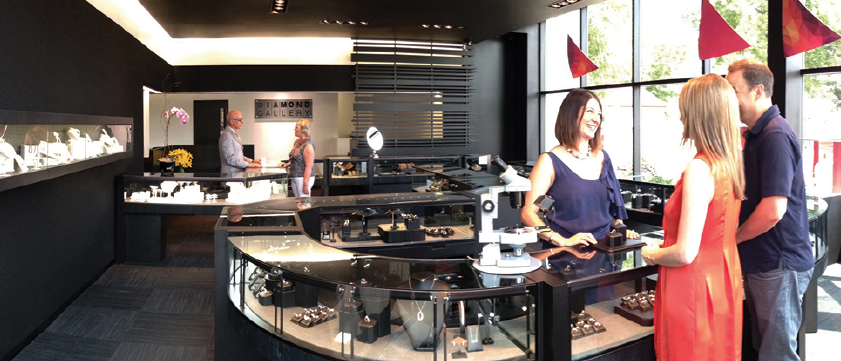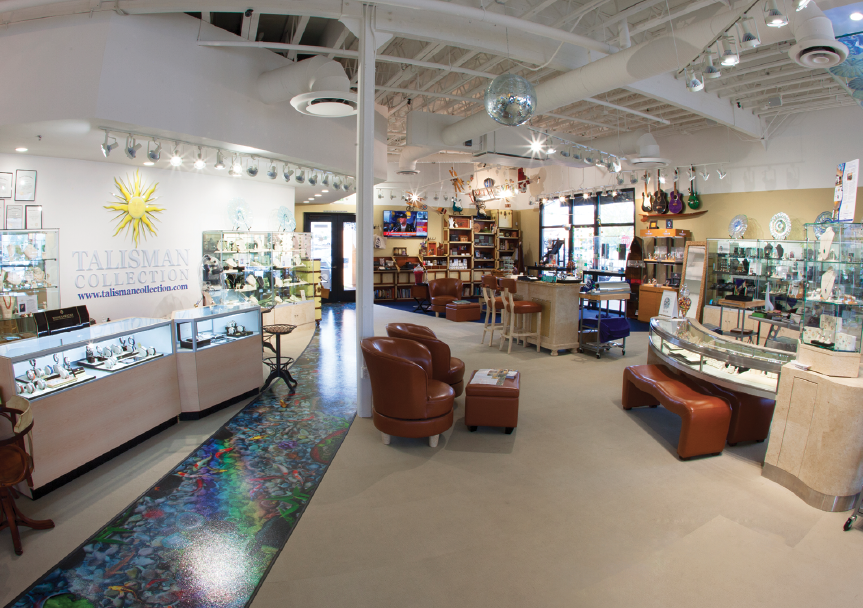
Andrea Riso of Talisman Collection in El Dorado Hills, CA.
Andrea Riso, owner of Talisman Collection in El Dorado Hills, CA, has made every effort to sell jewelry made fromrecycled metals and ethically sourced and fair-trade gemstones. Her building is certified for Leadership in Energy and Environmental Design (LEED). “It’s simply the right thing to do, Riso says. “I wanted to maintain a level of responsibility that goes beyond just being a good jeweler; I wanted to be a good member of the community.”
Only recently did she begin to include that information in Instagram posts. “I didn’t realize that people search for that,” she says.
While she can point to certification for the store itself, proof of ethical sourcing is complicated. “People want certificates that say stones are ethically sourced. We’re an AGS store, an AGTA store, and we work within the parameters that are available to us, but it’s often a matter of hoping that dealers are telling the truth.”
Those details are important.
According to the Jewelers Vigilance Committee’s Quality Assurance Guide, you, the retailer, cannot merely rely on a representation made by a supplier when describing products. If it turns out the supplier’s representations are inaccurate and you simply repeat what they tell you, you will be considered equally liable, especially if you have never done anything to check.
So, it’s vital to educate yourself about what you’re selling. Whether or not you promote your store as “green,” you need to be ready to answer questions. “Like most things in life, hiding your head in the sand is not to your benefit,” says Tiffany Stevens, president and CEO of Jewelers Vigilance Committee.
Advertisement
So, to begin with ask suppliers to fill out forms explaining where their goods come from and how they are procured and made. Emily Armenta, who has built her jewelry design business on the tenets of social responsibility, suggests asking suppliers if they belong to the Responsible Jewelry Council. It’s worth the effort: “If you can crystallize your brand message and your social responsibility together, you have a competitive edge,” Armenta says.
Don’t make any assumptions. If you assume that lab-created diamonds are “green” simply because they aren’t mined, you could be wrong, depending on how much electricity is used to create them, experts say.
Sales trainer Roxana Lucas urges retailers to implement their own quality-control measures. “Don’t base your reputation and liability on your supplier’s word,” she says. “You’re a third party by the time it gets to you. Ask really hard questions of your suppliers and make sure they can answer them.”
Whether or not you are able to make “green claims” about your building, your business or your inventory, there is another aspect to “going green” in which everyone can participate.
“A better story to tell than green claims is what the industry has done and is doing around responsible sourcing,” Stevens says. “Our industry has been under scrutiny for a long time and has developed responsible sourcing protocol going back to The Kimberley Process. The industry is doing all kinds of things to make sure we’re not sourcing things from conflict, from criminal terrorist financing. There are specific stories they can tell that parallel the emotional experience of buying jewelry.”
Such stories are being told by the Diamond Empowerment Fund, which invites retailers to share their own experiences for use both on its Facebook page, which has 175,000 followers, and its website diamondsdogood.com. It’s easy, too. Just fill out a form and a writer will create your good-news story.
“I find that everyone has their own idea of green,” says Allan Malbranck, owner of Diamond Gallery in Winnipeg, Manitoba, who was recognized by the Retail Council of Canada for the store’s sustainable design. “Each time you budget for a purchase of any kind, ask your supplier for a more green or sustainable option and have them include supporting documentation.”
Once you’re confident about what you’re selling, you can integrate it into sales presentations and marketing.
“Ethics-based purchasers need to feel good about the luxury they want,” Lucas says. “They want to buy products that align with their ethical standards, from businesses that share their values and their standards — protecting workers, saving energy and environment worldwide.”
Be aware that consumers may have heard more about problems than about solutions. Help consumers understand that spending money with you can create a positive impact. Make sustainability, social responsibility, community support and responsible sourcing part of your brand promise, your marketing message and every sales presentation.
“I highly recommend taking the opportunity we have as business owners to encourage change in the effort to make our world a better, more positive and healthier place to live and work,” Malbranck says. “I believe there will be a time when our grandchildren will ask us what we did when we had the opportunity to make their world better. The rewards, small or large, will be worth the investment.”
Retail Stores Going The Distance for Sustainability
Going To The Source
D&H Jewelers | San Francisco
Traveling the world, working for a Russian diamond company, Shawn Higgins had become deeply disillusioned with the jewelry industry.
“I started to see what terrible things this industry was doing to people,” he says. “Strip mining the Earth for metal. Forced mining labor. Individuals buying precious gemstones from small miners for pennies on the dollar. As I got older, I said, I’m done.”
But then Higgins met and worked with Lindsay Daunell, who had a background not only in fashion and jewelry, but also environmental studies; together the new business partners developed a concept for a sustainable retail business, which renewed Higgins’ interest in the industry.
The physical part of creating the San Francisco store was fairly simple. They installed LED lighting and bamboo walls and went to a junkyard to buy old doors. They made displays from discarded material, too. They dug through layers of carpet and linoleum to uncover circa 1880s wood floors, which they decided to keep, because keeping what was already there was, of course, the most sustainable thing to do. They created the Rose Cut Wine Bar within their store, where all of the wines served are local, kegged, and use biodynamic (chemical free) resourcing. The beautiful sycamore bar top was salvaged and put to good use after the tree serendipitously fell on a house their contractor was working on.

Shawn Higgins, left, and Lindsay Daunell, right, visit the Jwaneng diamond mine in Botswana with their guide.
Sourcing products for jewelry was far more complicated.
“I don’t trust anyone,” Higgins says.
He and Daunell personally verify every source of jewelry, gold or gemstones. “We traveled to Botswana, to see where the freshly mined diamonds were coming from,” he says. “We met diamond manufacturers, went to the mine, toured the mine, met the ministry of finance in Botswana. We went to Sri Lanka to visit my friend’s sapphire mine. He said 30 percent of the money was going to the people there. We wanted to make sure. And it was true.”
Ninety percent of their gold is reclaimed from consumer electronics. Says Higgins: “That source is in Canada. I went up there and met with the board.”
Giving back to gem-producing countries is also a goal they see coming to fruition. The duo has partnered with the Berkeley-based non-profit organization, The Ring Project, founded to fund civil initiatives in the Congo. So far, they’ve raised tens of thousands of dollars for scholarships for women. D&H purchases donated jewelry items in order to help fund this organization and has begun producing a line of jewelry using those recycled materials. “I appraise it, buy it for parts and pieces, we remake it as new jewelry and it’s creating a life cycle for women in the Congo,” Higgins says. “The Ring Project provides us with a source for the raw materials we use in our jewelry, in alignment with our core value of sustainability, through the repurposing of metals and diamonds,” Higgins says. “Giving back to the Earth, to people that we’ve taken so much from — it’s just the right thing to do.”
Advertisement

Green Building Design
The Diamond Gallery | Winnipeg, Manitoba, Canada
For Allan and Anita Malbranck, their adventures in “green” began when their young daughters, including Lisa, now a co-owner, encouraged them to start recycling in the 1980s.
Around the same time, Allan became keenly interested in the idea of sustainable business design as one important component of a business prepared for the future, one that was economically sustainable as well. In 2008, when Lisa joined them in the business, they acquired a property to build a new 10,000 square foot professional/retail building.
The building was designed to exceed industry standards for environmental efficiency in heating and cooling, lighting and plumbing. They knew they preferred showing diamonds in natural, southern light and learned that southern exposure benefits an energy-efficient building. So the building was designed to face south and is equipped with ceramic metal halide, energy-efficient fluorescents and LED showcase lighting. Using a lot of natural light in their business also creates a “wow” customer experience because half of their walls are formed by nearly floor to ceiling height windows.
But they didn’t stop there.

The Malbrancks were determined the whole building would be built to last, and so they encouraged the architect and electrical mechanical teams to incorporate cutting-edge technology to achieve those goals, even participating in weekly construction meetings. “A green building includes long-term design to minimize costly repairs and future landfill garbage,” Malbranck says.
It was built with a piled foundation designed to minimize future structural damage, a heated crawlspace for a warm first floor in winter and easy access to electrical and mechanical systems, low maintenance finishes and a white vinyl roof.
At the suggestion of their mechanical contractor, they decided to use geothermal energy for heating and cooling. Geothermal energy originates from the heat retained within the Earth’s core. Efficient from minus 40 to 100 degrees Fahrenheit, it operates with the help of two underground wells and heat pumps. Manitoba’s electricity is powered by hydroelectric generating stations, so choosing geothermal energy instead of natural gas made the building completely sustainable.
“We incorporate the benefit of our sustainable building into all the other benefits we offer, such as conflict-free, in-house branded diamonds, mostly in-house design work, high quality recycled precious metals without toxic rhodium plating, sustainably sourced and recyclable paper,” Malbranck says. They also offer their tenants reduced parking rates if they own an electric car and are beginning to make plans for solar panels on the roof.
“We believe that if all other decision-making comparisons are equal, a potential customer will choose Diamond Gallery for the exceptional experience, followed by our commitment to the environment,” Malbranck says.

Andrea Riso makes the most of available natural light to conserve energy in her store.
Certifiably Sustainable
The Talisman Collection | El Dorado Hills, CA
Andrea Riso owns Talisman Collection, an LEED-certified store. Riso’s rented space boasts LED lighting, recycled outdoor air and a very low footprint, ecologically. She uses only recycled metals and forms relationships with suppliers to determine their sourcing.
LEED, or Leadership in Energy and Environmental Design, is a globally recognized symbol of sustainability achievement and the most widely used green building rating system in the world.
“To me, it wasn’t an option not to do the build-out this way,” Riso says. “It took a little more research, but the same amount of money and the same amount of time. The benefits are being a good corporate citizen, having good karma, protecting the earth and leaving a smaller footprint.”
“I use way less lighting than a lot of other jewelry stores,” Riso says. “Not only do I not have bright jeweler’s lights but I have the lowest LED lights possible. And I have a lot of windows.”
In California, a measure of green is mandated for building. With the drought and fire cycle in the state, water is precious. She is often asked if the water she uses at her jeweler’s bench is recycled, which it is. When she’s had to use water outside, drivers have stopped their cars to question her. “People are very conscientious about the environment in California, more so than elsewhere in the United States,” Riso says.
Before opening Talisman, Riso was a communications consultant for NASA’s Sustainability Base in Moffett Field, CA, which opened in 2011 and became the “greenest” building in the federal government when it received Platinum LEED certification. She learned much from the experience that has been relevant in her current career.
“Everything I do in this business model is anti-greed, anti-over-consumption and anti-triple keystone margins.”

Chris Wattsson was surprised to learn that vintage light fixtures and cases could be retrofitted with energy efficient lighting.
Retrofitted Lighting
Wattsson & Wattsson | Marquette, MI
When Chris Wattsson was in high school, he built a hydrogen-fuel cell for his car, which took its MPG from 16 to 32. “That hooked me,” he says, on energy conservation.
So in 2014, Wattsson spent $13,000 on lighting in his store, working with the Energy Optimization Program through the Marquette Board of Light & Power. He retrofitted his 100-year-old cases and chandeliers for LED lighting, something he wasn’t even sure was possible. He replaced 100 60-watt incandescent decorative, candelabra-style bulbs in chandeliers with comparable LED bulbs that only use 7 watts.
“I have an original tin ceiling, and the lighting has helped to highlight its beauty while continuing to provide natural looking, bright light. Retrofitting the cases helped us to get the best color light to make the pieces really sparkle.”
LEDs can last 25 times longer than incandescent bulbs and use 80 percent less energy. He’s saving 26,000 kilowatts a year, which is equivalent to taking four cars off the road per year, or planting 80 trees per year. “Over the last few years, energy costs have skyrocketed in our area,” he says. “I cringe thinking about how much I would be spending on electricity if I hadn’t done the project.”
When he embarked on the lighting project, the chandelier lights cost $20 per bulb and now a better quality LED bulb is just $9.
It was so successful that the Michigan Energy Optimization program profiled his store. He also received $1,560 in Energy Optimization Program rebates, and the project was the highlight of his Business After Hours presentation in 2014. “Many people comment on the beauty of our original tin ceiling, which naturally leads into a discussion about how I was able to update everything. Certain customers are really interested in green issues. Being green is a passion of mine, so it’s something that I talk energetically about.”
Next he’s looking into solar and wind-power. “My dream is to have a solar farm on my roof.”
Advertisement
5 Ways Retailers Are Making a Difference
- 1. BY USING SOLAR POWER: Jonathan McCoy of McCoy Jewelers in Dubuque, IA, has a solar array on his roof that he describes as a long-term investment in the next generation. “Our setup is one in which we pull first from our solar array and then during peak times we get additional from the grid. When our production exceeds demand, it is routed back into the grid for others to use. In the future, as the products mature, we will add some sort of a battery so that we store the energy onsite for continuous uninterrupted power with the grid as our backup during the winter months and peak summer usage.”
- 2. BY RECYCLING PAPER PRODUCTS: Elizabeth Kittell of Pretty in Patina in Omaha, NE, says her shopping bags and tissues are recycled plain brown bags that they hand rubber-stamp in the store. “We sent out between 750 to 1,000 shopping bags in the month of June alone,” she says.
- 3. BY CHOOSING RENEWABLE MATERIALS: The fir and walnut wood used throughout Green Lake Jewelry Works’ Bellevue, WA, location was chosen to be sustainable. “We wanted to move away from mahogany, and we didn’t want to use any wood that would impact tropical rainforests,” says Jim Tuttle. Builders of J. David Jewelers in Tulsa, OK, framed the windows with squares made of recycled sugar cane, fashioned to look like 2-foot bronze tiles. Bill Welling, owner of Welling & Co. Jewelers in West Chester, OH, worked with interior designer Leslie McGwire on sustainability for his store. “Live Edge” recycled walnut tables are used to display jewelry.
- 4. BY BUYING CARBON OFFSETS: “Since I don’t own my own building,” says Babs Noelle, of Alara in Bozeman, MT, “I can’t very well install solar panels or other carbon offsetting measures. I had to figure something else out.” She learned she could purchase carbon offsets through various organizations (terrapass.com, green-e.org/certified-resources/carbon-offsets, nativeenergy.com, etc.). Most have a calculator on their website to determine the carbon footprint of your business based on electric and gas use, the mileage clocked by owners and staff travel. The business then purchases “offsets” that result in funds being spent elsewhere, such as developing wind and solar power.
- 5. BY WASHING DISHES: Pamela Rossi of PJ Rossi Jewelers in Fort Lauderdale, FL: “We built a kitchen in the store, use regular plates and silverware and do our own dishes!”
Ideas to Green Your Store
Here are some real tips, both small and large, to making your store more earth-friendly, according to Jesse Balaity of Balaity Property Enhancement and Ruth Mellergaard of GRID/3 International.
- Illuminate showcases with in-case and ceiling fixtures, but skip the general lighting along circulation paths. Reducing lighting on the floor between showcases helps the jewelry stand out by creating a rhythm of brighter and dimmer spaces throughout the store and reduces energy consumption. (BALAITY)
- Use large-scale graphics in windows, especially those that are west-facing. The graphics double as sun shades and can be an effective marketing tool for drive-by traffic. (BALAITY) If not graphics, then add film, which can make the building more secure, save energy and redirect light into the store. <(MELLERGAARD)
- Embrace modular carpet squares. Often dismissed as too expensive or too corporate, carpet squares are more cost-competitive and fashion-forward than ever. Instead of filling landfills with rolls of carpet every 10 years, you can replace just the squares in high traffic areas as needed. (BALAITY)
- Stop it with the coffee pods and plastic water bottles! Customers will appreciate more labor-intensive beverage systems when pitched as part of an environmental initiative. (BALAITY)
- Install light sensors like occupancy and vacancy sensors, plus natural-light-triggered time clocks and dimming controls. (MELLERGAARD)
- Invest in exterior lights that control the direction of the light with “hats” that reduce the amount of light transmitted after dark. (MELLERGAARD)
- Always look for low VOC (volatile oil compounds) products for painting or cleaning. (MELLERGAARD)
- Add real plants to your interior. Try ficus, English ivy, spider plant, golden pothos and peace lily — all add oxygen to the air and remove carbon dioxide while eliminating common pollutants such as formaldehyde. (MELLERGAARD)
- Use recycled materials such as carpet tile with recycled fiber or reclaimed wood. (MELLERGAARD)